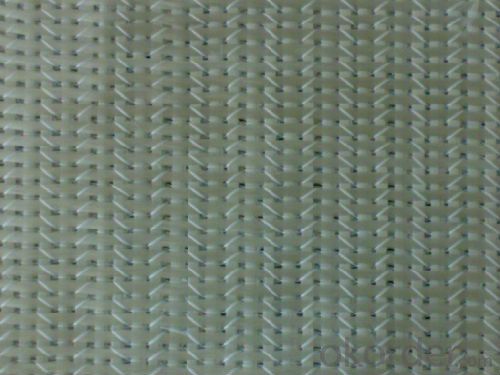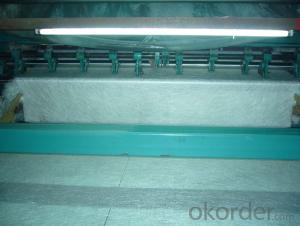E-Glass Stitched Chopped Mat (450g/m2~900g/m2)
- Loading Port:
- Shanghai
- Payment Terms:
- TT or LC
- Min Order Qty:
- 20000 kg
- Supply Capability:
- 200000kg Per Month kg/month
OKorder Service Pledge
OKorder Financial Service
You Might Also Like
1.Brief Introductions
E-Glass Stitched Chopped Mat (450g/m2~900g/m2) is made by chopping continuous strands into chopped strands and stitching them together. The product has a maximum width of 110 inches. This product can be used in manufacturing boat manufacturing and tubes.
2.Product Features
Fast breakdown in styrene
Good wet-through and fast wet-out in resins, rapid air lease
Superior acid corrosion resistance
3.Product Specifications
Item | Over Density | Moisture Content | Chop Density | Polyester Yarn | Width |
(g/m2) | (%) | (g/m2) | (g/m2) | (mm) | |
EMK300 | 309.5 | ≤0.15 | 300 | 9.5 | 50-3300 |
EMK380 | 399 | 380 | 19 | ||
EMK450 | 459.5 | 450 | 9.5 | ||
EMK450 | 469 | 450 | 19 | ||
EMC0020 | 620.9 | 601.9 | 19 | ||
EMC0030 | 909.5 | 900 | 9.5 |
Special specification can be produce according to customer requirements.

4.FAQ
Packaging:
E-Glass Stitched Chopped Strand Mat is wound onto a paper tube which has an inside diameter of 76mm and the mat roll has a diameter of 275mm. The mat roll is wrapped up with plastic film,and then packed in a cardboard box or wrapped up with kraft paper. The rolls can be horizontally placed. For transportation, the rolls can be loaded into a cantainer directly or on pallets.
Storage:
Unless otherwise specified, E-Glass Stitched Chopped Strand Mat should be stored in a dry, cool and rain-proof area. It is recommended that the room temperature and humidity should be always maintained at 15℃~35℃ and 35%~65% respectively.
- Q:Can fiberglass mat tissue be used for automotive repairs?
- Yes, fiberglass mat tissue can be used for automotive repairs. Fiberglass mat tissue is a versatile material that is commonly used in various industries, including the automotive industry. It is often used for reinforcing and repairing auto body panels, as well as fixing cracks, holes, and other damages in the vehicle's body. Fiberglass mat tissue is made up of fine fibers that are bound together with a resin. This composition gives it excellent strength and flexibility, making it ideal for automotive repairs. It can be easily shaped and molded to fit different contours and shapes of car parts, ensuring a seamless repair. Additionally, fiberglass mat tissue is lightweight and durable, which is crucial for automotive repairs. It provides excellent resistance against corrosion, weathering, and other external elements, ensuring the longevity of the repair. It also offers good impact resistance, protecting the repaired area from further damage. Furthermore, fiberglass mat tissue is compatible with various types of automotive coatings, such as primers, paints, and clear coats. This allows for a smooth and professional finish after the repair is complete. In conclusion, fiberglass mat tissue is a suitable material for automotive repairs due to its strength, flexibility, durability, and compatibility with automotive coatings. It is commonly used in the industry for reinforcing and repairing auto body panels, fixing damages, and ensuring a seamless finish.
- Q:What are the different reinforcement densities available for fiberglass mat tissue?
- The different reinforcement densities available for fiberglass mat tissue can vary depending on the specific manufacturer and product. However, common options include low density (lightweight), medium density, and high density fiberglass mat tissues. These densities are designed to provide different levels of strength, flexibility, and durability for various applications in industries such as construction, automotive, and marine.
- Q:Is fiberglass mat tissue fire resistant?
- Certainly, fiberglass mat tissue exhibits fire resistance. This quality originates from its composition of glass fibers and resin, which grants it exceptional fire-resistant attributes. Possessing a considerable melting point, it resists ignition and combustion with ease. Moreover, fiberglass mat tissue frequently undergoes treatment with fire-resistant coatings or additives, bolstering its fire-resistant capabilities to an even greater extent. Consequently, fiberglass mat tissue finds extensive use in diverse applications necessitating fire resistance, including insulation materials, protective clothing, and fireproof barriers.
- Q:Is fiberglass mat tissue suitable for railway rolling stock?
- Indeed, fiberglass mat tissue proves to be a fitting option for railway rolling stock. This lightweight and resilient material is frequently utilized in the construction sector for a multitude of purposes, including the production of railway rolling stock. Its exceptional mechanical robustness and resistance to corrosion render it optimal for deployment in the challenging and rigorous settings characteristic of railway rolling stock operations. Furthermore, fiberglass mat tissue exhibits commendable thermal insulation characteristics, contributing to enhanced energy efficiency within the rolling stock. All in all, fiberglass mat tissue emerges as a suitable and dependable selection for the construction and upkeep of railway rolling stock.
- Q:What are the advantages of using fiberglass mat tissue in construction?
- Using fiberglass mat tissue in construction offers several advantages. Firstly, it provides excellent reinforcement and strength to construction materials, enhancing their durability and resistance to cracks, impacts, and weathering. This makes it an ideal choice for reinforcing concrete, roofing materials, and composite products. Secondly, fiberglass mat tissue is lightweight and easy to handle, making it convenient for construction purposes. Unlike heavy steel reinforcements, it can be easily cut, shaped, and applied without requiring specialized tools. This saves both labor and time, resulting in cost savings. Additionally, fiberglass mat tissue is non-corrosive and non-conductive, making it suitable for various environments. It remains unaffected by rust or degradation, even in harsh conditions, ensuring the longevity and reliability of the construction. Moreover, it does not conduct electricity, which is crucial for applications where electrical conductivity must be avoided. Furthermore, fiberglass mat tissue offers excellent thermal insulation properties. It acts as a barrier to heat transfer, creating a comfortable and energy-efficient interior environment. This can lead to reduced heating and cooling costs, making it a sustainable and cost-effective choice. Lastly, fiberglass mat tissue is resistant to fire and chemicals. It does not burn or release toxic fumes when exposed to flames, providing an added level of safety in construction. It also withstands many chemicals, including acids and alkalis, making it suitable for corrosive environments such as chemical plants or industrial facilities. In conclusion, the benefits of using fiberglass mat tissue in construction include enhanced reinforcement, lightweight and easy handling, non-corrosive and non-conductive properties, thermal insulation, fire resistance, and chemical resistance. These advantages make it a versatile and reliable material for various construction applications.
- Q:Is fiberglass mat tissue resistant to pests and insects?
- Pests and insects usually find fiberglass mat tissue to be non-resistant. Although pests do not consider fiberglass itself as a source of food, they may be attracted to the binders and resins utilized during manufacturing. Furthermore, pests can gain access through tiny cracks or openings in the fiberglass. Nevertheless, it is possible to enhance the resistance of fiberglass mat tissue against pests and insects by applying specialized chemicals or coatings. Consulting a professional or the manufacturer is advised to determine the most suitable method for achieving pest and insect resistance in fiberglass mat tissue.
- Q:Can fiberglass mat tissue be used for windbreak panels?
- Yes, fiberglass mat tissue can be used for windbreak panels. Fiberglass mat tissue is a lightweight and flexible material that is commonly used in various applications such as insulation, reinforcing materials, and structural support. It is known for its high strength-to-weight ratio, durability, and resistance to weather and environmental conditions. When used in windbreak panels, fiberglass mat tissue can provide additional reinforcement and stability to the panels. It can help withstand strong winds and prevent damage or breakage, making it an effective choice for windbreak panels. Moreover, fiberglass mat tissue is also known for its excellent thermal and acoustic insulation properties. This can be beneficial in windbreak panels as it can help to reduce noise and regulate temperature, creating a more comfortable and protected environment. Additionally, fiberglass mat tissue is fire-resistant, making it a safe option for windbreak panels. Overall, fiberglass mat tissue can be a suitable and reliable material for windbreak panels due to its strength, durability, insulation properties, and resistance to environmental conditions.
- Q:Can fiberglass mat tissue be used for making insulation boards?
- Yes, fiberglass mat tissue can be used for making insulation boards. The tissue provides strength, stability, and reinforcement to the insulation material, making it an effective choice for insulation board manufacturing.
- Q:What is the composition of fiberglass mat tissue?
- Fiberglass mat tissue, also known as fiberglass mat or fiberglass veil, is made up of a combination of fiberglass fibers and a binder material. The fiberglass fibers used in the composition are typically made from silica, a naturally occurring mineral. These fibers are known for their high strength and durability. The binder material used in fiberglass mat tissue can vary, but commonly includes substances like urea-formaldehyde, acrylic, or polyester resins. The role of the binder is to hold the fiberglass fibers together and provide structural integrity to the mat. In addition to the fiberglass fibers and binder, other additives may be included in the composition of fiberglass mat tissue. These additives can include substances such as pigments, fire retardants, or coatings, depending on the specific application and desired properties of the mat. Overall, the composition of fiberglass mat tissue is a combination of fiberglass fibers and a binder material, with additional additives depending on the intended use. This composition allows fiberglass mat tissue to possess excellent strength, flexibility, and resistance to various environmental factors, making it a versatile material used in various industries such as construction, automotive, aerospace, and marine.
- Q:Is fiberglass mat tissue recyclable?
- Indeed, fiberglass mat tissue can be recycled. It is crafted from a fusion of glass fibers and typically resin, serving as a binding material. Once the material becomes unnecessary or completes its life span, it can undergo recycling by disassembling the glass fibers from the binder material. Subsequently, the glass fibers can be liquefied and utilized in the production of novel fiberglass goods, while the binder material can be processed and repurposed in alternative applications. The act of recycling fiberglass mat tissue aids in waste reduction and the preservation of natural resources, rendering it a sustainable choice.
1. Manufacturer Overview |
|
|---|---|
| Location | |
| Year Established | |
| Annual Output Value | |
| Main Markets | |
| Company Certifications | |
2. Manufacturer Certificates |
|
|---|---|
| a) Certification Name | |
| Range | |
| Reference | |
| Validity Period | |
3. Manufacturer Capability |
|
|---|---|
| a)Trade Capacity | |
| Nearest Port | |
| Export Percentage | |
| No.of Employees in Trade Department | |
| Language Spoken: | |
| b)Factory Information | |
| Factory Size: | |
| No. of Production Lines | |
| Contract Manufacturing | |
| Product Price Range | |
Send your message to us
E-Glass Stitched Chopped Mat (450g/m2~900g/m2)
- Loading Port:
- Shanghai
- Payment Terms:
- TT or LC
- Min Order Qty:
- 20000 kg
- Supply Capability:
- 200000kg Per Month kg/month
OKorder Service Pledge
OKorder Financial Service
Similar products
New products
Hot products
Related keywords





























